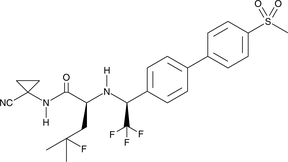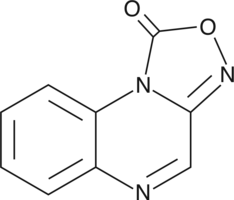Cayman
Showing 33001–33150 of 45550 results
-
Octanoyl-DL-carnitine is a medium-chain acylcarnitine. It decreases the oxidation rate of the branched-chain 2-oxo acids 3-methyl-2-butanoate and 4-methyl-2-oxopentanoate in isolated rat muscle mitochondria in the presence of carnitine, but increases it in the absence of carnitine.{55274} Octanoyl-DL-carnitine, with malate, has been used as a mitochondrial respiration substrate to measure the effect of creatine on the respiration rate of isolated rat cardiac fibers exposed to increasing concentrations of ADP.{55275}
Brand:CaymanSKU:-Octanoyl-DL-carnitine is a medium-chain acylcarnitine. It decreases the oxidation rate of the branched-chain 2-oxo acids 3-methyl-2-butanoate and 4-methyl-2-oxopentanoate in isolated rat muscle mitochondria in the presence of carnitine, but increases it in the absence of carnitine.{55274} Octanoyl-DL-carnitine, with malate, has been used as a mitochondrial respiration substrate to measure the effect of creatine on the respiration rate of isolated rat cardiac fibers exposed to increasing concentrations of ADP.{55275}
Brand:CaymanSKU:-Octanoyl-L-carnitine is a medium-chain acylcarnitine and the physiologically active form of octanoyl-DL-carnitine (Item No. 15048).{47123} Plasma levels of octanoyl-L-carnitine are elevated in patients with end-stage renal disease on continuous ambulatory peritoneal dialysis (PD) compared with both patients on automated PD and healthy individuals.{47277} Octanoyl-L-carnitine does not undergo hydrolysis in the blood or during sample preparation when used as a standard for the quantification of octanoylcarnitine.{47123}
Brand:CaymanSKU:26558 - 10 mgAvailable on backorder
Octanoyl-L-carnitine is a medium-chain acylcarnitine and the physiologically active form of octanoyl-DL-carnitine (Item No. 15048).{47123} Plasma levels of octanoyl-L-carnitine are elevated in patients with end-stage renal disease on continuous ambulatory peritoneal dialysis (PD) compared with both patients on automated PD and healthy individuals.{47277} Octanoyl-L-carnitine does not undergo hydrolysis in the blood or during sample preparation when used as a standard for the quantification of octanoylcarnitine.{47123}
Brand:CaymanSKU:26558 - 5 mgAvailable on backorder
Octanoyl-L-carnitine is a medium-chain acylcarnitine and the physiologically active form of octanoyl-DL-carnitine (Item No. 15048).{47123} Plasma levels of octanoyl-L-carnitine are elevated in patients with end-stage renal disease on continuous ambulatory peritoneal dialysis (PD) compared with both patients on automated PD and healthy individuals.{47277} Octanoyl-L-carnitine does not undergo hydrolysis in the blood or during sample preparation when used as a standard for the quantification of octanoylcarnitine.{47123}
Brand:CaymanSKU:26558 - 50 mgAvailable on backorder
Octanoyl-L-carnitine-d3 is intended for use as an internal standard for the quantification of octanoyl-L-carnitine (Item No. 26558) by GC- or LC-MS. Octanoyl-L-carnitine is a medium-chain acylcarnitine and the physiologically active form of octanoyl-DL-carnitine (Item No. 15048).{47123} Plasma levels of octanoyl-L-carnitine are elevated in patients with end-stage renal disease on continuous ambulatory peritoneal dialysis (PD) compared with both patients on automated PD and healthy individuals.{47277} Octanoyl-L-carnitine does not undergo hydrolysis in the blood or during sample preparation when used as a standard for the quantification of octanoylcarnitine.{47123}
Brand:CaymanSKU:26577 - 1 mgAvailable on backorder
Octanoyl-L-carnitine-d3 is intended for use as an internal standard for the quantification of octanoyl-L-carnitine (Item No. 26558) by GC- or LC-MS. Octanoyl-L-carnitine is a medium-chain acylcarnitine and the physiologically active form of octanoyl-DL-carnitine (Item No. 15048).{47123} Plasma levels of octanoyl-L-carnitine are elevated in patients with end-stage renal disease on continuous ambulatory peritoneal dialysis (PD) compared with both patients on automated PD and healthy individuals.{47277} Octanoyl-L-carnitine does not undergo hydrolysis in the blood or during sample preparation when used as a standard for the quantification of octanoylcarnitine.{47123}
Brand:CaymanSKU:26577 - 10 mgAvailable on backorder
Octanoyl-L-carnitine-d3 is intended for use as an internal standard for the quantification of octanoyl-L-carnitine (Item No. 26558) by GC- or LC-MS. Octanoyl-L-carnitine is a medium-chain acylcarnitine and the physiologically active form of octanoyl-DL-carnitine (Item No. 15048).{47123} Plasma levels of octanoyl-L-carnitine are elevated in patients with end-stage renal disease on continuous ambulatory peritoneal dialysis (PD) compared with both patients on automated PD and healthy individuals.{47277} Octanoyl-L-carnitine does not undergo hydrolysis in the blood or during sample preparation when used as a standard for the quantification of octanoylcarnitine.{47123}
Brand:CaymanSKU:26577 - 5 mgAvailable on backorder
Octodrine (hydrochloride) (Item No. 21927) is an analytical reference standard categorized as a stimulant.{40385} This product is intended for research and forensic applications.
Brand:CaymanSKU:21927 -Out of stock
Octodrine (hydrochloride) (Item No. 21927) is an analytical reference standard categorized as a stimulant.{40385} This product is intended for research and forensic applications.
Brand:CaymanSKU:21927 -Out of stock
Octreotide is an octapeptide analog of somatostatin that binds to somatostatin receptors (SSTRs) with a higher affinity for the somatostatin subgroup 2 receptors, SST2, SST3, and SST5 (Kis = 875, 0.57, 26.8, >1,000, and 6.8 nM for SST1-5 receptors, respectively).{41295} Within subgroup 2 SSTRs, it selectively binds to SST2 over SST3 and SST5 receptors with IC50 values of 0.02, 92.9, and 21.8 nM, respectively, for human receptors. Octreotide inhibits the secretion of growth hormone in vitro in rat pituitary cells three-fold more potently than somatostatin and in vivo in rhesus monkey (ID50 = 0.38 µg/kg per hour).{41293} It inhibits proliferation of VEGF-stimulated human umbilical endothelial cells (HUVECs) with an EC50 value of approximately 1 µM.{41294} It also inhibits growth of LCI-D20 human hepatocellular carcinoma cell tumors in a nude mouse xenograft model when administered at a dose of 50 µg/kg twice daily. Formulations containing octreotide have been used in the treatment of acromegaly to reduce growth hormone and IGF-1 levels.
Brand:CaymanSKU:23757 - 1 mgAvailable on backorder
Octreotide is an octapeptide analog of somatostatin that binds to somatostatin receptors (SSTRs) with a higher affinity for the somatostatin subgroup 2 receptors, SST2, SST3, and SST5 (Kis = 875, 0.57, 26.8, >1,000, and 6.8 nM for SST1-5 receptors, respectively).{41295} Within subgroup 2 SSTRs, it selectively binds to SST2 over SST3 and SST5 receptors with IC50 values of 0.02, 92.9, and 21.8 nM, respectively, for human receptors. Octreotide inhibits the secretion of growth hormone in vitro in rat pituitary cells three-fold more potently than somatostatin and in vivo in rhesus monkey (ID50 = 0.38 µg/kg per hour).{41293} It inhibits proliferation of VEGF-stimulated human umbilical endothelial cells (HUVECs) with an EC50 value of approximately 1 µM.{41294} It also inhibits growth of LCI-D20 human hepatocellular carcinoma cell tumors in a nude mouse xenograft model when administered at a dose of 50 µg/kg twice daily. Formulations containing octreotide have been used in the treatment of acromegaly to reduce growth hormone and IGF-1 levels.
Brand:CaymanSKU:23757 - 10 mgAvailable on backorder
Octreotide is an octapeptide analog of somatostatin that binds to somatostatin receptors (SSTRs) with a higher affinity for the somatostatin subgroup 2 receptors, SST2, SST3, and SST5 (Kis = 875, 0.57, 26.8, >1,000, and 6.8 nM for SST1-5 receptors, respectively).{41295} Within subgroup 2 SSTRs, it selectively binds to SST2 over SST3 and SST5 receptors with IC50 values of 0.02, 92.9, and 21.8 nM, respectively, for human receptors. Octreotide inhibits the secretion of growth hormone in vitro in rat pituitary cells three-fold more potently than somatostatin and in vivo in rhesus monkey (ID50 = 0.38 µg/kg per hour).{41293} It inhibits proliferation of VEGF-stimulated human umbilical endothelial cells (HUVECs) with an EC50 value of approximately 1 µM.{41294} It also inhibits growth of LCI-D20 human hepatocellular carcinoma cell tumors in a nude mouse xenograft model when administered at a dose of 50 µg/kg twice daily. Formulations containing octreotide have been used in the treatment of acromegaly to reduce growth hormone and IGF-1 levels.
Brand:CaymanSKU:23757 - 25 mgAvailable on backorder
Octreotide is an octapeptide analog of somatostatin that binds to somatostatin receptors (SSTRs) with a higher affinity for the somatostatin subgroup 2 receptors, SST2, SST3, and SST5 (Kis = 875, 0.57, 26.8, >1,000, and 6.8 nM for SST1-5 receptors, respectively).{41295} Within subgroup 2 SSTRs, it selectively binds to SST2 over SST3 and SST5 receptors with IC50 values of 0.02, 92.9, and 21.8 nM, respectively, for human receptors. Octreotide inhibits the secretion of growth hormone in vitro in rat pituitary cells three-fold more potently than somatostatin and in vivo in rhesus monkey (ID50 = 0.38 µg/kg per hour).{41293} It inhibits proliferation of VEGF-stimulated human umbilical endothelial cells (HUVECs) with an EC50 value of approximately 1 µM.{41294} It also inhibits growth of LCI-D20 human hepatocellular carcinoma cell tumors in a nude mouse xenograft model when administered at a dose of 50 µg/kg twice daily. Formulations containing octreotide have been used in the treatment of acromegaly to reduce growth hormone and IGF-1 levels.
Brand:CaymanSKU:23757 - 5 mgAvailable on backorder
α-Hydroxyglutaric acid (2-HG; Item No. 16374) is normally metabolized to 2-oxoglutarate by D- and L-2-hydroxyglutarate dehydrogenases. Mutations in these enzymes cause 2-hydroxyglutaric aciduria, a neurometabolic disorder.{26770,26771,26772} Recent studies have found that mutations in isocitrate dehydrogenase 1 (IDH1) and IDH2, typically associated with certain cancers, can cause these enzymes to convert isocitrate to 2-HG, rather than α-ketoglutarate.{26773,26775} 2-HG is structurally similar to α-ketoglutarate and competitively inhibits α-ketoglutarate-dependent dioxygenases, including lysine demethylases and DNA hydroxylases.{26775,26774,26769} Octyl-α-hydroxyglutarate is a cell-permeable derivative of 2-HG.
Brand:CaymanSKU:-Out of stock
α-Hydroxyglutaric acid (2-HG; Item No. 16374) is normally metabolized to 2-oxoglutarate by D- and L-2-hydroxyglutarate dehydrogenases. Mutations in these enzymes cause 2-hydroxyglutaric aciduria, a neurometabolic disorder.{26770,26771,26772} Recent studies have found that mutations in isocitrate dehydrogenase 1 (IDH1) and IDH2, typically associated with certain cancers, can cause these enzymes to convert isocitrate to 2-HG, rather than α-ketoglutarate.{26773,26775} 2-HG is structurally similar to α-ketoglutarate and competitively inhibits α-ketoglutarate-dependent dioxygenases, including lysine demethylases and DNA hydroxylases.{26775,26774,26769} Octyl-α-hydroxyglutarate is a cell-permeable derivative of 2-HG.
Brand:CaymanSKU:-Out of stock
α-Hydroxyglutaric acid (2-HG; Item No. 16374) is normally metabolized to 2-oxoglutarate by D- and L-2-hydroxyglutarate dehydrogenases. Mutations in these enzymes cause 2-hydroxyglutaric aciduria, a neurometabolic disorder.{26770,26771,26772} Recent studies have found that mutations in isocitrate dehydrogenase 1 (IDH1) and IDH2, typically associated with certain cancers, can cause these enzymes to convert isocitrate to 2-HG, rather than α-ketoglutarate.{26773,26775} 2-HG is structurally similar to α-ketoglutarate and competitively inhibits α-ketoglutarate-dependent dioxygenases, including lysine demethylases and DNA hydroxylases.{26775,26774,26769} Octyl-α-hydroxyglutarate is a cell-permeable derivative of 2-HG.
Brand:CaymanSKU:-Out of stock
Hypoxia-inducible factor 1α (HIF-1α) turnover is initiated by prolyl hydroxylases (PHD), which hydroxylate proline residues on HIF-1α, facilitating ubiquitination. PHD activity is linked to the tricarboxylic acid (TCA) cycle, since the intermediate α-ketoglutarate is a PHD substrate and succinate and fumarate inhibit PHD. Mutations in enzymes associated with the TCA cycle occur in certain cancers.{21411} Octyl-α-ketoglutarate is a stable, cell-permeable form of α-ketoglutarate which accumulates rapidly and preferentially in cells with a dysfunctional TCA cycle.{21289} When used at 1 mM, it stimulates PHD activity, increasing HIF-1α turnover.{21289,21410} In addition, octyl-α-ketoglutarate competitively blocks succinate- or fumarate-mediated inhibition of PHD.{21289}
Brand:CaymanSKU:11970 - 1 mgAvailable on backorder
Hypoxia-inducible factor 1α (HIF-1α) turnover is initiated by prolyl hydroxylases (PHD), which hydroxylate proline residues on HIF-1α, facilitating ubiquitination. PHD activity is linked to the tricarboxylic acid (TCA) cycle, since the intermediate α-ketoglutarate is a PHD substrate and succinate and fumarate inhibit PHD. Mutations in enzymes associated with the TCA cycle occur in certain cancers.{21411} Octyl-α-ketoglutarate is a stable, cell-permeable form of α-ketoglutarate which accumulates rapidly and preferentially in cells with a dysfunctional TCA cycle.{21289} When used at 1 mM, it stimulates PHD activity, increasing HIF-1α turnover.{21289,21410} In addition, octyl-α-ketoglutarate competitively blocks succinate- or fumarate-mediated inhibition of PHD.{21289}
Brand:CaymanSKU:11970 - 10 mgAvailable on backorder
Hypoxia-inducible factor 1α (HIF-1α) turnover is initiated by prolyl hydroxylases (PHD), which hydroxylate proline residues on HIF-1α, facilitating ubiquitination. PHD activity is linked to the tricarboxylic acid (TCA) cycle, since the intermediate α-ketoglutarate is a PHD substrate and succinate and fumarate inhibit PHD. Mutations in enzymes associated with the TCA cycle occur in certain cancers.{21411} Octyl-α-ketoglutarate is a stable, cell-permeable form of α-ketoglutarate which accumulates rapidly and preferentially in cells with a dysfunctional TCA cycle.{21289} When used at 1 mM, it stimulates PHD activity, increasing HIF-1α turnover.{21289,21410} In addition, octyl-α-ketoglutarate competitively blocks succinate- or fumarate-mediated inhibition of PHD.{21289}
Brand:CaymanSKU:11970 - 5 mgAvailable on backorder
Odanacatib is a potent, selective, and neutral inhibitor of cathepsin K (IC50s = 0.2 and 1 nM for human and rabbit enzymes, respectively), a protease involved in osteoclastic bone resorption.{33648} It demonstrates high selectivity for cathepsin K over cathepsins B, L, and S. Formulations containing odanacatib reduce bone resorption, with lesser reductions in bone formation, resulting in increased bone mineral density.{33647,33649}
Brand:CaymanSKU:21466 -Out of stock
Odanacatib is a potent, selective, and neutral inhibitor of cathepsin K (IC50s = 0.2 and 1 nM for human and rabbit enzymes, respectively), a protease involved in osteoclastic bone resorption.{33648} It demonstrates high selectivity for cathepsin K over cathepsins B, L, and S. Formulations containing odanacatib reduce bone resorption, with lesser reductions in bone formation, resulting in increased bone mineral density.{33647,33649}
Brand:CaymanSKU:21466 -Out of stock
Odanacatib is a potent, selective, and neutral inhibitor of cathepsin K (IC50s = 0.2 and 1 nM for human and rabbit enzymes, respectively), a protease involved in osteoclastic bone resorption.{33648} It demonstrates high selectivity for cathepsin K over cathepsins B, L, and S. Formulations containing odanacatib reduce bone resorption, with lesser reductions in bone formation, resulting in increased bone mineral density.{33647,33649}
Brand:CaymanSKU:21466 -Out of stock
Odanacatib is a potent, selective, and neutral inhibitor of cathepsin K (IC50s = 0.2 and 1 nM for human and rabbit enzymes, respectively), a protease involved in osteoclastic bone resorption.{33648} It demonstrates high selectivity for cathepsin K over cathepsins B, L, and S. Formulations containing odanacatib reduce bone resorption, with lesser reductions in bone formation, resulting in increased bone mineral density.{33647,33649}
Brand:CaymanSKU:21466 -Out of stock
ODM-201 is an androgen receptor (AR) antagonist (Ki = 11 nM).{42404} It inhibits AR transactivation in U2OS osteosarcoma cells expressing human wild-type and mutant ARs (IC50s = 65, 66, 1,500, and 1,782 nM for wild-type, ARF876L, ARW741L, and ART877A, respectively). ODM-201 prevents androgen-induced AR nuclear translocation in AR-overexpressing HS-HEK293 and LNCaP cells and suppresses androgen-induced proliferation of VCaP cells (IC50 = 230 nM). In vivo, ODM-201 (50 mg/kg per day) reduces tumor growth in a VCaP castrated mouse xenograft model. It also inhibits tumor growth without increasing serum testosterone levels in a VCaP intact mouse xenograft model.
Brand:CaymanSKU:25643 - 1 mgAvailable on backorder
ODM-201 is an androgen receptor (AR) antagonist (Ki = 11 nM).{42404} It inhibits AR transactivation in U2OS osteosarcoma cells expressing human wild-type and mutant ARs (IC50s = 65, 66, 1,500, and 1,782 nM for wild-type, ARF876L, ARW741L, and ART877A, respectively). ODM-201 prevents androgen-induced AR nuclear translocation in AR-overexpressing HS-HEK293 and LNCaP cells and suppresses androgen-induced proliferation of VCaP cells (IC50 = 230 nM). In vivo, ODM-201 (50 mg/kg per day) reduces tumor growth in a VCaP castrated mouse xenograft model. It also inhibits tumor growth without increasing serum testosterone levels in a VCaP intact mouse xenograft model.
Brand:CaymanSKU:25643 - 10 mgAvailable on backorder
ODM-201 is an androgen receptor (AR) antagonist (Ki = 11 nM).{42404} It inhibits AR transactivation in U2OS osteosarcoma cells expressing human wild-type and mutant ARs (IC50s = 65, 66, 1,500, and 1,782 nM for wild-type, ARF876L, ARW741L, and ART877A, respectively). ODM-201 prevents androgen-induced AR nuclear translocation in AR-overexpressing HS-HEK293 and LNCaP cells and suppresses androgen-induced proliferation of VCaP cells (IC50 = 230 nM). In vivo, ODM-201 (50 mg/kg per day) reduces tumor growth in a VCaP castrated mouse xenograft model. It also inhibits tumor growth without increasing serum testosterone levels in a VCaP intact mouse xenograft model.
Brand:CaymanSKU:25643 - 25 mgAvailable on backorder
ODM-201 is an androgen receptor (AR) antagonist (Ki = 11 nM).{42404} It inhibits AR transactivation in U2OS osteosarcoma cells expressing human wild-type and mutant ARs (IC50s = 65, 66, 1,500, and 1,782 nM for wild-type, ARF876L, ARW741L, and ART877A, respectively). ODM-201 prevents androgen-induced AR nuclear translocation in AR-overexpressing HS-HEK293 and LNCaP cells and suppresses androgen-induced proliferation of VCaP cells (IC50 = 230 nM). In vivo, ODM-201 (50 mg/kg per day) reduces tumor growth in a VCaP castrated mouse xenograft model. It also inhibits tumor growth without increasing serum testosterone levels in a VCaP intact mouse xenograft model.
Brand:CaymanSKU:25643 - 5 mgAvailable on backorder
ODM-203 is a dual inhibitor of VEGFR and FGFR (IC50s = 5-26 and 6-35 nM for VEGFR1-3 and FGFR1-4, respectively).{59184} It is selective for VEGFR1-3 and FGFR1-4 over a panel of 308 kinases at 1 µM, but does inhibit the receptor tyrosine kinases PDGFRα, PDGFRβ, and DDR1 (IC50s = 35, 169, and 6 nM, respectively), as well as MAP4K4, MINK1, RET, SIK2, YES1, and Tie2 (IC50s = 49, 41, 8, 23, 152, and 174 nM, respectively). ODM-203 inhibits FGFR-dependent proliferation in H1581 lung, SNU-16 stomach, and RT4 bladder cancer cells (IC50s = 104, 132, and 192 nM, respectively) and VEGF-induced tube formation by human umbilical vein endothelial cells (HUVECs; IC50 = 33 nM). In vivo, ODM-203 (20 and 40 mg/kg) decreases tumor volume in an RT4 mouse xenograft model. It also reduces tumor growth and intratumor phosphorylation of FGFR in a SNU-16 mouse xenograft model when administered at a dose of 30 mg/kg.
Brand:CaymanSKU:31451 - 10 mgAvailable on backorder
ODM-203 is a dual inhibitor of VEGFR and FGFR (IC50s = 5-26 and 6-35 nM for VEGFR1-3 and FGFR1-4, respectively).{59184} It is selective for VEGFR1-3 and FGFR1-4 over a panel of 308 kinases at 1 µM, but does inhibit the receptor tyrosine kinases PDGFRα, PDGFRβ, and DDR1 (IC50s = 35, 169, and 6 nM, respectively), as well as MAP4K4, MINK1, RET, SIK2, YES1, and Tie2 (IC50s = 49, 41, 8, 23, 152, and 174 nM, respectively). ODM-203 inhibits FGFR-dependent proliferation in H1581 lung, SNU-16 stomach, and RT4 bladder cancer cells (IC50s = 104, 132, and 192 nM, respectively) and VEGF-induced tube formation by human umbilical vein endothelial cells (HUVECs; IC50 = 33 nM). In vivo, ODM-203 (20 and 40 mg/kg) decreases tumor volume in an RT4 mouse xenograft model. It also reduces tumor growth and intratumor phosphorylation of FGFR in a SNU-16 mouse xenograft model when administered at a dose of 30 mg/kg.
Brand:CaymanSKU:31451 - 25 mgAvailable on backorder
ODM-203 is a dual inhibitor of VEGFR and FGFR (IC50s = 5-26 and 6-35 nM for VEGFR1-3 and FGFR1-4, respectively).{59184} It is selective for VEGFR1-3 and FGFR1-4 over a panel of 308 kinases at 1 µM, but does inhibit the receptor tyrosine kinases PDGFRα, PDGFRβ, and DDR1 (IC50s = 35, 169, and 6 nM, respectively), as well as MAP4K4, MINK1, RET, SIK2, YES1, and Tie2 (IC50s = 49, 41, 8, 23, 152, and 174 nM, respectively). ODM-203 inhibits FGFR-dependent proliferation in H1581 lung, SNU-16 stomach, and RT4 bladder cancer cells (IC50s = 104, 132, and 192 nM, respectively) and VEGF-induced tube formation by human umbilical vein endothelial cells (HUVECs; IC50 = 33 nM). In vivo, ODM-203 (20 and 40 mg/kg) decreases tumor volume in an RT4 mouse xenograft model. It also reduces tumor growth and intratumor phosphorylation of FGFR in a SNU-16 mouse xenograft model when administered at a dose of 30 mg/kg.
Brand:CaymanSKU:31451 - 5 mgAvailable on backorder
ODM-203 is a dual inhibitor of VEGFR and FGFR (IC50s = 5-26 and 6-35 nM for VEGFR1-3 and FGFR1-4, respectively).{59184} It is selective for VEGFR1-3 and FGFR1-4 over a panel of 308 kinases at 1 µM, but does inhibit the receptor tyrosine kinases PDGFRα, PDGFRβ, and DDR1 (IC50s = 35, 169, and 6 nM, respectively), as well as MAP4K4, MINK1, RET, SIK2, YES1, and Tie2 (IC50s = 49, 41, 8, 23, 152, and 174 nM, respectively). ODM-203 inhibits FGFR-dependent proliferation in H1581 lung, SNU-16 stomach, and RT4 bladder cancer cells (IC50s = 104, 132, and 192 nM, respectively) and VEGF-induced tube formation by human umbilical vein endothelial cells (HUVECs; IC50 = 33 nM). In vivo, ODM-203 (20 and 40 mg/kg) decreases tumor volume in an RT4 mouse xenograft model. It also reduces tumor growth and intratumor phosphorylation of FGFR in a SNU-16 mouse xenograft model when administered at a dose of 30 mg/kg.
Brand:CaymanSKU:31451 - 50 mgAvailable on backorder
ODQ is a highly selective, irreversible, heme-site inhibitor of soluble guanylyl cyclase.{3115,2939} The binding of ODQ is competitive with NO. The inhibition of soluble guanylyl cyclase is time dependent with complete inactivation in 10 minutes at 0.3 µM ODQ.{2939}
Brand:CaymanSKU:81410 - 10 mgAvailable on backorder
ODQ is a highly selective, irreversible, heme-site inhibitor of soluble guanylyl cyclase.{3115,2939} The binding of ODQ is competitive with NO. The inhibition of soluble guanylyl cyclase is time dependent with complete inactivation in 10 minutes at 0.3 µM ODQ.{2939}
Brand:CaymanSKU:81410 - 100 mgAvailable on backorder
ODQ is a highly selective, irreversible, heme-site inhibitor of soluble guanylyl cyclase.{3115,2939} The binding of ODQ is competitive with NO. The inhibition of soluble guanylyl cyclase is time dependent with complete inactivation in 10 minutes at 0.3 µM ODQ.{2939}
Brand:CaymanSKU:81410 - 5 mgAvailable on backorder
ODQ is a highly selective, irreversible, heme-site inhibitor of soluble guanylyl cyclase.{3115,2939} The binding of ODQ is competitive with NO. The inhibition of soluble guanylyl cyclase is time dependent with complete inactivation in 10 minutes at 0.3 µM ODQ.{2939}
Brand:CaymanSKU:81410 - 50 mgAvailable on backorder
Oenin is a natural anthocyanin found in plants. It is the 3-glucoside of malvidin, an O-methylated anthocyanidin. Oenin has neuroprotective effects, reducing amyloid β-induced cytotoxicity and diminishing reactive oxygen species production in Neuro-2A cells when applied at 50 µM.{26207} Oenin, at 30 µM, also stimulates autophagy in human osteosarcoma U2OS cells.{26208}
Brand:CaymanSKU:-Oenin is a natural anthocyanin found in plants. It is the 3-glucoside of malvidin, an O-methylated anthocyanidin. Oenin has neuroprotective effects, reducing amyloid β-induced cytotoxicity and diminishing reactive oxygen species production in Neuro-2A cells when applied at 50 µM.{26207} Oenin, at 30 µM, also stimulates autophagy in human osteosarcoma U2OS cells.{26208}
Brand:CaymanSKU:-Oenin is a natural anthocyanin found in plants. It is the 3-glucoside of malvidin, an O-methylated anthocyanidin. Oenin has neuroprotective effects, reducing amyloid β-induced cytotoxicity and diminishing reactive oxygen species production in Neuro-2A cells when applied at 50 µM.{26207} Oenin, at 30 µM, also stimulates autophagy in human osteosarcoma U2OS cells.{26208}
Brand:CaymanSKU:-Oenin is a natural anthocyanin found in plants. It is the 3-glucoside of malvidin, an O-methylated anthocyanidin. Oenin has neuroprotective effects, reducing amyloid β-induced cytotoxicity and diminishing reactive oxygen species production in Neuro-2A cells when applied at 50 µM.{26207} Oenin, at 30 µM, also stimulates autophagy in human osteosarcoma U2OS cells.{26208}
Brand:CaymanSKU:-OF-1 is a chemical probe for the bromodomains of the Bromodomain and PHD Finger-containing (BRPF) family of proteins. It binds BRPF1B, BRPF2, and BRPF3 with Kd values of 0.1, 0.5, and 2.4 µM, respectively, as determined by isothermal titration calorimetry. OF-1 increases thermal stability of full length BRPF1B at 1 µM, in the cellular thermal shift assay. It also demonstrates accelerated fluorescence recovery after photobleaching (FRAP) at 5 µM in the BRPF2 FRAP assay. OF-1 shows modest general cytotoxicity. See the Structural Genomics Consortium (SGC) website for further information.
Brand:CaymanSKU:-Out of stock
OF-1 is a chemical probe for the bromodomains of the Bromodomain and PHD Finger-containing (BRPF) family of proteins. It binds BRPF1B, BRPF2, and BRPF3 with Kd values of 0.1, 0.5, and 2.4 µM, respectively, as determined by isothermal titration calorimetry. OF-1 increases thermal stability of full length BRPF1B at 1 µM, in the cellular thermal shift assay. It also demonstrates accelerated fluorescence recovery after photobleaching (FRAP) at 5 µM in the BRPF2 FRAP assay. OF-1 shows modest general cytotoxicity. See the Structural Genomics Consortium (SGC) website for further information.
Brand:CaymanSKU:-Out of stock
OF-1 is a chemical probe for the bromodomains of the Bromodomain and PHD Finger-containing (BRPF) family of proteins. It binds BRPF1B, BRPF2, and BRPF3 with Kd values of 0.1, 0.5, and 2.4 µM, respectively, as determined by isothermal titration calorimetry. OF-1 increases thermal stability of full length BRPF1B at 1 µM, in the cellular thermal shift assay. It also demonstrates accelerated fluorescence recovery after photobleaching (FRAP) at 5 µM in the BRPF2 FRAP assay. OF-1 shows modest general cytotoxicity. See the Structural Genomics Consortium (SGC) website for further information.
Brand:CaymanSKU:-Out of stock
OF-1 is a chemical probe for the bromodomains of the Bromodomain and PHD Finger-containing (BRPF) family of proteins. It binds BRPF1B, BRPF2, and BRPF3 with Kd values of 0.1, 0.5, and 2.4 µM, respectively, as determined by isothermal titration calorimetry. OF-1 increases thermal stability of full length BRPF1B at 1 µM, in the cellular thermal shift assay. It also demonstrates accelerated fluorescence recovery after photobleaching (FRAP) at 5 µM in the BRPF2 FRAP assay. OF-1 shows modest general cytotoxicity. See the Structural Genomics Consortium (SGC) website for further information.
Brand:CaymanSKU:-Out of stock
Lysine-specific demethylase 1 (LSD1) is a protein lysine demethylase that specifically demethylates histone H3 lysine 4 (H3K4) and H3K9, resulting in transcriptional repression.{14724} Host LSD1 is also recruited by certain viruses to limit H3K9 methylation, which can repress viral genes necessary for infection.{28724} Lysine-specific demethylase 1 (LSD1) is a protein lysine demethylase that specifically demethylates histone H3 lysine 4 (H3K4) and H3K9, resulting in transcriptional repression.{14724} Host LSD1 is also recruited by certain viruses to limit H3K9 methylation, which can repress viral genes necessary for infection.{28724} OG-L002 is a potent inhibitor of LSD1 (IC50 = 0.02 µM) that less effectively inhibits the monoamine oxidases A (MAO-A) and MAO-B (IC50s = 1.38 and 0.72 µM).{28724} It blocks the expression of immediate early (IE) genes of herpes simplex virus (HSV) in HeLa cells but not that of cellular control genes.{28724} OG-L002 also reduces the expression of human cytomegalovirus IE genes and adenovirus E1A gene in mammalian cells.{28724} It is effective in vivo, repressing HSV primary infection in mice and blocking HSV reactivation from latency in a mouse ganglion explant model.{28724}
Brand:CaymanSKU:-Available on backorder
Lysine-specific demethylase 1 (LSD1) is a protein lysine demethylase that specifically demethylates histone H3 lysine 4 (H3K4) and H3K9, resulting in transcriptional repression.{14724} Host LSD1 is also recruited by certain viruses to limit H3K9 methylation, which can repress viral genes necessary for infection.{28724} Lysine-specific demethylase 1 (LSD1) is a protein lysine demethylase that specifically demethylates histone H3 lysine 4 (H3K4) and H3K9, resulting in transcriptional repression.{14724} Host LSD1 is also recruited by certain viruses to limit H3K9 methylation, which can repress viral genes necessary for infection.{28724} OG-L002 is a potent inhibitor of LSD1 (IC50 = 0.02 µM) that less effectively inhibits the monoamine oxidases A (MAO-A) and MAO-B (IC50s = 1.38 and 0.72 µM).{28724} It blocks the expression of immediate early (IE) genes of herpes simplex virus (HSV) in HeLa cells but not that of cellular control genes.{28724} OG-L002 also reduces the expression of human cytomegalovirus IE genes and adenovirus E1A gene in mammalian cells.{28724} It is effective in vivo, repressing HSV primary infection in mice and blocking HSV reactivation from latency in a mouse ganglion explant model.{28724}
Brand:CaymanSKU:-Available on backorder
Lysine-specific demethylase 1 (LSD1) is a protein lysine demethylase that specifically demethylates histone H3 lysine 4 (H3K4) and H3K9, resulting in transcriptional repression.{14724} Host LSD1 is also recruited by certain viruses to limit H3K9 methylation, which can repress viral genes necessary for infection.{28724} Lysine-specific demethylase 1 (LSD1) is a protein lysine demethylase that specifically demethylates histone H3 lysine 4 (H3K4) and H3K9, resulting in transcriptional repression.{14724} Host LSD1 is also recruited by certain viruses to limit H3K9 methylation, which can repress viral genes necessary for infection.{28724} OG-L002 is a potent inhibitor of LSD1 (IC50 = 0.02 µM) that less effectively inhibits the monoamine oxidases A (MAO-A) and MAO-B (IC50s = 1.38 and 0.72 µM).{28724} It blocks the expression of immediate early (IE) genes of herpes simplex virus (HSV) in HeLa cells but not that of cellular control genes.{28724} OG-L002 also reduces the expression of human cytomegalovirus IE genes and adenovirus E1A gene in mammalian cells.{28724} It is effective in vivo, repressing HSV primary infection in mice and blocking HSV reactivation from latency in a mouse ganglion explant model.{28724}
Brand:CaymanSKU:-Available on backorder
Lysine-specific demethylase 1 (LSD1) is a protein lysine demethylase that specifically demethylates histone H3 lysine 4 (H3K4) and H3K9, resulting in transcriptional repression.{14724} Host LSD1 is also recruited by certain viruses to limit H3K9 methylation, which can repress viral genes necessary for infection.{28724} Lysine-specific demethylase 1 (LSD1) is a protein lysine demethylase that specifically demethylates histone H3 lysine 4 (H3K4) and H3K9, resulting in transcriptional repression.{14724} Host LSD1 is also recruited by certain viruses to limit H3K9 methylation, which can repress viral genes necessary for infection.{28724} OG-L002 is a potent inhibitor of LSD1 (IC50 = 0.02 µM) that less effectively inhibits the monoamine oxidases A (MAO-A) and MAO-B (IC50s = 1.38 and 0.72 µM).{28724} It blocks the expression of immediate early (IE) genes of herpes simplex virus (HSV) in HeLa cells but not that of cellular control genes.{28724} OG-L002 also reduces the expression of human cytomegalovirus IE genes and adenovirus E1A gene in mammalian cells.{28724} It is effective in vivo, repressing HSV primary infection in mice and blocking HSV reactivation from latency in a mouse ganglion explant model.{28724}
Brand:CaymanSKU:-Available on backorder
OGG1-IN-O8 is an inhibitor of 8-oxoguanine DNA glycosylase 1 (OGG1; IC50 = 0.35 µM).{53335} It is selective for OGG1 over Nei-like DNA glycosylase 1 (NEIL1), endonuclease III homolog 1 (NTH1), and formamidopyrimidine DNA glycosylase (Fpg) at 50 µM.
Brand:CaymanSKU:29769 - 1 mgAvailable on backorder
OGG1-IN-O8 is an inhibitor of 8-oxoguanine DNA glycosylase 1 (OGG1; IC50 = 0.35 µM).{53335} It is selective for OGG1 over Nei-like DNA glycosylase 1 (NEIL1), endonuclease III homolog 1 (NTH1), and formamidopyrimidine DNA glycosylase (Fpg) at 50 µM.
Brand:CaymanSKU:29769 - 10 mgAvailable on backorder
OGG1-IN-O8 is an inhibitor of 8-oxoguanine DNA glycosylase 1 (OGG1; IC50 = 0.35 µM).{53335} It is selective for OGG1 over Nei-like DNA glycosylase 1 (NEIL1), endonuclease III homolog 1 (NTH1), and formamidopyrimidine DNA glycosylase (Fpg) at 50 µM.
Brand:CaymanSKU:29769 - 25 mgAvailable on backorder
OGG1-IN-O8 is an inhibitor of 8-oxoguanine DNA glycosylase 1 (OGG1; IC50 = 0.35 µM).{53335} It is selective for OGG1 over Nei-like DNA glycosylase 1 (NEIL1), endonuclease III homolog 1 (NTH1), and formamidopyrimidine DNA glycosylase (Fpg) at 50 µM.
Brand:CaymanSKU:29769 - 5 mgAvailable on backorder
OH-C-Chol is a cationic cholesterol derivative.{45145} OH-C-Chol, as a component of lipoplexes with DOPE (Item No. 15091), has been used for siRNA delivery and gene silencing in MCF-7 cells as well as in mice via intravenous injection, resulting in lipoplex accumulation in the liver.
Brand:CaymanSKU:26587 - 1 mgAvailable on backorder
OH-C-Chol is a cationic cholesterol derivative.{45145} OH-C-Chol, as a component of lipoplexes with DOPE (Item No. 15091), has been used for siRNA delivery and gene silencing in MCF-7 cells as well as in mice via intravenous injection, resulting in lipoplex accumulation in the liver.
Brand:CaymanSKU:26587 - 500 µgAvailable on backorder
OH-Chol is a cationic cholesterol derivative.{45145} OH-Chol, as a component of lipoplexes with DOPE (Item No. 15091), has been used for siRNA delivery and gene silencing in MCF-7 cells, as well as in mice via intravenous injection, resulting in lipoplex accumulation in the liver. It has also been used in cationic nanoparticles in combination with Tween 80 to transfect pDNA and siRNA into PC3 mouse xenografts via intratumoral injection and with Tween 80 and folate-PEG2000-DSPE in a KB mouse xenograft model for intratumoral gene delivery.{45299}
Brand:CaymanSKU:26586 - 1 mgAvailable on backorder
OH-Chol is a cationic cholesterol derivative.{45145} OH-Chol, as a component of lipoplexes with DOPE (Item No. 15091), has been used for siRNA delivery and gene silencing in MCF-7 cells, as well as in mice via intravenous injection, resulting in lipoplex accumulation in the liver. It has also been used in cationic nanoparticles in combination with Tween 80 to transfect pDNA and siRNA into PC3 mouse xenografts via intratumoral injection and with Tween 80 and folate-PEG2000-DSPE in a KB mouse xenograft model for intratumoral gene delivery.{45299}
Brand:CaymanSKU:26586 - 10 mgAvailable on backorder
OH-Chol is a cationic cholesterol derivative.{45145} OH-Chol, as a component of lipoplexes with DOPE (Item No. 15091), has been used for siRNA delivery and gene silencing in MCF-7 cells, as well as in mice via intravenous injection, resulting in lipoplex accumulation in the liver. It has also been used in cationic nanoparticles in combination with Tween 80 to transfect pDNA and siRNA into PC3 mouse xenografts via intratumoral injection and with Tween 80 and folate-PEG2000-DSPE in a KB mouse xenograft model for intratumoral gene delivery.{45299}
Brand:CaymanSKU:26586 - 25 mgAvailable on backorder
OH-Chol is a cationic cholesterol derivative.{45145} OH-Chol, as a component of lipoplexes with DOPE (Item No. 15091), has been used for siRNA delivery and gene silencing in MCF-7 cells, as well as in mice via intravenous injection, resulting in lipoplex accumulation in the liver. It has also been used in cationic nanoparticles in combination with Tween 80 to transfect pDNA and siRNA into PC3 mouse xenografts via intratumoral injection and with Tween 80 and folate-PEG2000-DSPE in a KB mouse xenograft model for intratumoral gene delivery.{45299}
Brand:CaymanSKU:26586 - 5 mgAvailable on backorder
WD-repeat protein 5 (WDR5) is a scaffold protein commonly involved in the formation of nucleosome-modifying protein complexes with histones.{22296} For example, WDR5 is a component of a mixed-lineage leukemia (MLL) methyltransferase complex that targets histone 3.{20287} WDR5 can also be a component of histone acetyltransferase complexes and can directly bind methylated as well as unmodified histones.{22296,24221} OICR-9429 is a chemical probe that inhibits the interaction of WDR5 with peptide regions of MLL and Histone 3, demonstrating >100-fold selectivity over other chromatin reader domains, methyltransferases, and other non-epigenetic targets. It selectively binds to WDR5 (Kd = 24-52 nM) and disrupts its interaction with MLL1 and RbBP5 in cells (IC50 = Structural Genomics Consortium (SGC). The negative control, OICR-0547, for OICR-9429 is also available exclusively through the SGC. You can submit a request to receive the negative control here.
Brand:CaymanSKU:-WD-repeat protein 5 (WDR5) is a scaffold protein commonly involved in the formation of nucleosome-modifying protein complexes with histones.{22296} For example, WDR5 is a component of a mixed-lineage leukemia (MLL) methyltransferase complex that targets histone 3.{20287} WDR5 can also be a component of histone acetyltransferase complexes and can directly bind methylated as well as unmodified histones.{22296,24221} OICR-9429 is a chemical probe that inhibits the interaction of WDR5 with peptide regions of MLL and Histone 3, demonstrating >100-fold selectivity over other chromatin reader domains, methyltransferases, and other non-epigenetic targets. It selectively binds to WDR5 (Kd = 24-52 nM) and disrupts its interaction with MLL1 and RbBP5 in cells (IC50 = Structural Genomics Consortium (SGC). The negative control, OICR-0547, for OICR-9429 is also available exclusively through the SGC. You can submit a request to receive the negative control here.
Brand:CaymanSKU:-WD-repeat protein 5 (WDR5) is a scaffold protein commonly involved in the formation of nucleosome-modifying protein complexes with histones.{22296} For example, WDR5 is a component of a mixed-lineage leukemia (MLL) methyltransferase complex that targets histone 3.{20287} WDR5 can also be a component of histone acetyltransferase complexes and can directly bind methylated as well as unmodified histones.{22296,24221} OICR-9429 is a chemical probe that inhibits the interaction of WDR5 with peptide regions of MLL and Histone 3, demonstrating >100-fold selectivity over other chromatin reader domains, methyltransferases, and other non-epigenetic targets. It selectively binds to WDR5 (Kd = 24-52 nM) and disrupts its interaction with MLL1 and RbBP5 in cells (IC50 = Structural Genomics Consortium (SGC). The negative control, OICR-0547, for OICR-9429 is also available exclusively through the SGC. You can submit a request to receive the negative control here.
Brand:CaymanSKU:-WD-repeat protein 5 (WDR5) is a scaffold protein commonly involved in the formation of nucleosome-modifying protein complexes with histones.{22296} For example, WDR5 is a component of a mixed-lineage leukemia (MLL) methyltransferase complex that targets histone 3.{20287} WDR5 can also be a component of histone acetyltransferase complexes and can directly bind methylated as well as unmodified histones.{22296,24221} OICR-9429 is a chemical probe that inhibits the interaction of WDR5 with peptide regions of MLL and Histone 3, demonstrating >100-fold selectivity over other chromatin reader domains, methyltransferases, and other non-epigenetic targets. It selectively binds to WDR5 (Kd = 24-52 nM) and disrupts its interaction with MLL1 and RbBP5 in cells (IC50 = Structural Genomics Consortium (SGC). The negative control, OICR-0547, for OICR-9429 is also available exclusively through the SGC. You can submit a request to receive the negative control here.
Brand:CaymanSKU:-Okadaic acid is a marine sponge toxin which potently inhibits certain serine/threonine protein phosphatases. This cell permeable inhibitor targets the multiple isoforms of PP1 (IC50 = 10-50 nM), both isoforms of PP2A (IC50 = 0.5 nM) and PP3 (IC50 = 4 nM).{21676,21677,21678} It is a very weak inhibitor of PP2B (IC50 > 2 μM) and does not inhibit PP2C or other phosphatases.{21676,21678} Presumably through these actions, okadaic acid is a potent carcinogen and induces tau phosphorylation.{21680,21681} In sponge, okadaic acid plays a role in defense, inducing apoptosis in symbiotic or parasitic annelids.{21679}
Brand:CaymanSKU:10011490 - 100 µgAvailable on backorder
Okadaic acid is a marine sponge toxin which potently inhibits certain serine/threonine protein phosphatases. This cell permeable inhibitor targets the multiple isoforms of PP1 (IC50 = 10-50 nM), both isoforms of PP2A (IC50 = 0.5 nM) and PP3 (IC50 = 4 nM).{21676,21677,21678} It is a very weak inhibitor of PP2B (IC50 > 2 μM) and does not inhibit PP2C or other phosphatases.{21676,21678} Presumably through these actions, okadaic acid is a potent carcinogen and induces tau phosphorylation.{21680,21681} In sponge, okadaic acid plays a role in defense, inducing apoptosis in symbiotic or parasitic annelids.{21679}
Brand:CaymanSKU:10011490 - 25 µgAvailable on backorder
Okadaic acid is a marine sponge toxin which potently inhibits certain serine/threonine protein phosphatases. This cell permeable inhibitor targets the multiple isoforms of PP1 (IC50 = 10-50 nM), both isoforms of PP2A (IC50 = 0.5 nM) and PP3 (IC50 = 4 nM).{21676,21677,21678} It is a very weak inhibitor of PP2B (IC50 > 2 μM) and does not inhibit PP2C or other phosphatases.{21676,21678} Presumably through these actions, okadaic acid is a potent carcinogen and induces tau phosphorylation.{21680,21681} In sponge, okadaic acid plays a role in defense, inducing apoptosis in symbiotic or parasitic annelids.{21679}
Brand:CaymanSKU:10011490 - 50 µgAvailable on backorder
Olanzapine is an atypical antipsychotic that binds to dopamine D1, D2, and D4 receptors (Kis = 31, 11, and 27 nM, respectively) as well as the serotonin (5-HT) receptor subtypes 5-HT2A, 5-HT2C, and 5-HT3 (Kis = 4, 11, and 57 nM, respectively).{21347} It also binds to M1 muscarinic acetylcholine, α1-adrenergic, and histamine H1 receptors (Kis = 2, 19, and 7 nM, respectively). Olanzapine (0.5 mg/kg, i.p.) decreases immobility time in the forced swim test in non-stressed and prenatally-stressed rats, indicating antidepressant-like activity.{42431} It also decreases the number of avoidances made in the conditioned avoidance response test in rats when administered at doses of 0.5 and 1 mg/kg.{42432} Formulations containing olanzapine have been used in the treatment of schizophrenia and bipolar disorder.
Brand:CaymanSKU:11937 - 100 mgAvailable on backorder
Olanzapine is an atypical antipsychotic that binds to dopamine D1, D2, and D4 receptors (Kis = 31, 11, and 27 nM, respectively) as well as the serotonin (5-HT) receptor subtypes 5-HT2A, 5-HT2C, and 5-HT3 (Kis = 4, 11, and 57 nM, respectively).{21347} It also binds to M1 muscarinic acetylcholine, α1-adrenergic, and histamine H1 receptors (Kis = 2, 19, and 7 nM, respectively). Olanzapine (0.5 mg/kg, i.p.) decreases immobility time in the forced swim test in non-stressed and prenatally-stressed rats, indicating antidepressant-like activity.{42431} It also decreases the number of avoidances made in the conditioned avoidance response test in rats when administered at doses of 0.5 and 1 mg/kg.{42432} Formulations containing olanzapine have been used in the treatment of schizophrenia and bipolar disorder.
Brand:CaymanSKU:11937 - 25 mgAvailable on backorder
Olanzapine is an atypical antipsychotic that binds to dopamine D1, D2, and D4 receptors (Kis = 31, 11, and 27 nM, respectively) as well as the serotonin (5-HT) receptor subtypes 5-HT2A, 5-HT2C, and 5-HT3 (Kis = 4, 11, and 57 nM, respectively).{21347} It also binds to M1 muscarinic acetylcholine, α1-adrenergic, and histamine H1 receptors (Kis = 2, 19, and 7 nM, respectively). Olanzapine (0.5 mg/kg, i.p.) decreases immobility time in the forced swim test in non-stressed and prenatally-stressed rats, indicating antidepressant-like activity.{42431} It also decreases the number of avoidances made in the conditioned avoidance response test in rats when administered at doses of 0.5 and 1 mg/kg.{42432} Formulations containing olanzapine have been used in the treatment of schizophrenia and bipolar disorder.
Brand:CaymanSKU:11937 - 50 mgAvailable on backorder
Olanzapine thiolactam impurity is a potential impurity found in commercial preparations of olanzapine.{42725} It is a degradation product formed during storage or exposure to thermal stress.
Brand:CaymanSKU:27784 - 1 mgAvailable on backorder
Olanzapine thiolactam impurity is a potential impurity found in commercial preparations of olanzapine.{42725} It is a degradation product formed during storage or exposure to thermal stress.
Brand:CaymanSKU:27784 - 500 µgAvailable on backorder
Olanzapine-d8 is intended for use as an internal standard for the quantification of olanzapine (Item No. 11937) by GC- or LC-MS. Olanzapine is an atypical antipsychotic that binds to dopamine D1, D2, and D4 receptors (Kis = 31, 11, and 27 nM, respectively) as well as the serotonin (5-HT) receptor subtypes 5-HT2A, 5-HT2C, and 5-HT3 (Kis = 4, 11, and 57 nM, respectively).{21347} It also binds to M1 muscarinic acetylcholine, α1-adrenergic, and histamine H1 receptors (Kis = 2, 19, and 7 nM, respectively). Olanzapine (0.5 mg/kg, i.p.) decreases immobility time in the forced swim test in non-stressed and prenatally-stressed rats, indicating antidepressant-like activity.{42431} It also decreases the number of avoidances made in the conditioned avoidance response test in rats when administered at doses of 0.5 and 1 mg/kg.{42432} Formulations containing olanzapine have been used in the treatment of schizophrenia and bipolar disorder.
Brand:CaymanSKU:25447 - 1 mgAvailable on backorder
Olanzapine-d8 is intended for use as an internal standard for the quantification of olanzapine (Item No. 11937) by GC- or LC-MS. Olanzapine is an atypical antipsychotic that binds to dopamine D1, D2, and D4 receptors (Kis = 31, 11, and 27 nM, respectively) as well as the serotonin (5-HT) receptor subtypes 5-HT2A, 5-HT2C, and 5-HT3 (Kis = 4, 11, and 57 nM, respectively).{21347} It also binds to M1 muscarinic acetylcholine, α1-adrenergic, and histamine H1 receptors (Kis = 2, 19, and 7 nM, respectively). Olanzapine (0.5 mg/kg, i.p.) decreases immobility time in the forced swim test in non-stressed and prenatally-stressed rats, indicating antidepressant-like activity.{42431} It also decreases the number of avoidances made in the conditioned avoidance response test in rats when administered at doses of 0.5 and 1 mg/kg.{42432} Formulations containing olanzapine have been used in the treatment of schizophrenia and bipolar disorder.
Brand:CaymanSKU:25447 - 500 µgAvailable on backorder
Many of the products generated by alkylating agents on DNA can be efficiently repaired by normal base excision repair (BER).{20677} Some poly(ADP-ribose) polymerases (PARPs) assist in the repair of single-strand DNA nicks, an important step in BER.{22577} Olaparib is a potent inhibitor of PARP1 and PARP2 (IC50 = 5 and 1 nM, respectively) but is less effective against the PARP tankyrase-1 (IC50 = 1.5 µM).{24275} It can be used in cells and in animals, alone or in combination therapy with alkylating agents, to block BER and increase cancer cell death.{24275,20554,20549,20553}
Brand:CaymanSKU:10621 - 10 mgAvailable on backorder
Many of the products generated by alkylating agents on DNA can be efficiently repaired by normal base excision repair (BER).{20677} Some poly(ADP-ribose) polymerases (PARPs) assist in the repair of single-strand DNA nicks, an important step in BER.{22577} Olaparib is a potent inhibitor of PARP1 and PARP2 (IC50 = 5 and 1 nM, respectively) but is less effective against the PARP tankyrase-1 (IC50 = 1.5 µM).{24275} It can be used in cells and in animals, alone or in combination therapy with alkylating agents, to block BER and increase cancer cell death.{24275,20554,20549,20553}
Brand:CaymanSKU:10621 - 100 mgAvailable on backorder
Many of the products generated by alkylating agents on DNA can be efficiently repaired by normal base excision repair (BER).{20677} Some poly(ADP-ribose) polymerases (PARPs) assist in the repair of single-strand DNA nicks, an important step in BER.{22577} Olaparib is a potent inhibitor of PARP1 and PARP2 (IC50 = 5 and 1 nM, respectively) but is less effective against the PARP tankyrase-1 (IC50 = 1.5 µM).{24275} It can be used in cells and in animals, alone or in combination therapy with alkylating agents, to block BER and increase cancer cell death.{24275,20554,20549,20553}
Brand:CaymanSKU:10621 - 25 mgAvailable on backorder
Many of the products generated by alkylating agents on DNA can be efficiently repaired by normal base excision repair (BER).{20677} Some poly(ADP-ribose) polymerases (PARPs) assist in the repair of single-strand DNA nicks, an important step in BER.{22577} Olaparib is a potent inhibitor of PARP1 and PARP2 (IC50 = 5 and 1 nM, respectively) but is less effective against the PARP tankyrase-1 (IC50 = 1.5 µM).{24275} It can be used in cells and in animals, alone or in combination therapy with alkylating agents, to block BER and increase cancer cell death.{24275,20554,20549,20553}
Brand:CaymanSKU:10621 - 5 mgAvailable on backorder
Olaquindox is an antibiotic and a swine growth regulator.{46313} In vivo, olaquindox (100 mg/kg) decreases E. coli-induced diarrhea and the number of intraepithelial lymphocytes in the ileum and increases body weight in geld piglets. Olaquindox induces bleeding, intramuscular edema, vacuolar degeneration, and deformation of renal tubules in C. carpio.{46314} It decreases mean body weight and increases the number of dead fetuses in pregnant rats when administered at a dose of 110 mg/kg and increases the number of external deformities, including bent tail, craniorachischisis, exencephaly, and anophthalmia in rat pups born to exposed pregnant mothers.{46315} Formulations containing olaquindox have been used as growth promoting agents in bovine livestock.
Brand:CaymanSKU:27725 - 100 mgAvailable on backorder
Olaquindox is an antibiotic and a swine growth regulator.{46313} In vivo, olaquindox (100 mg/kg) decreases E. coli-induced diarrhea and the number of intraepithelial lymphocytes in the ileum and increases body weight in geld piglets. Olaquindox induces bleeding, intramuscular edema, vacuolar degeneration, and deformation of renal tubules in C. carpio.{46314} It decreases mean body weight and increases the number of dead fetuses in pregnant rats when administered at a dose of 110 mg/kg and increases the number of external deformities, including bent tail, craniorachischisis, exencephaly, and anophthalmia in rat pups born to exposed pregnant mothers.{46315} Formulations containing olaquindox have been used as growth promoting agents in bovine livestock.
Brand:CaymanSKU:27725 - 250 mgAvailable on backorder
Olaquindox is an antibiotic and a swine growth regulator.{46313} In vivo, olaquindox (100 mg/kg) decreases E. coli-induced diarrhea and the number of intraepithelial lymphocytes in the ileum and increases body weight in geld piglets. Olaquindox induces bleeding, intramuscular edema, vacuolar degeneration, and deformation of renal tubules in C. carpio.{46314} It decreases mean body weight and increases the number of dead fetuses in pregnant rats when administered at a dose of 110 mg/kg and increases the number of external deformities, including bent tail, craniorachischisis, exencephaly, and anophthalmia in rat pups born to exposed pregnant mothers.{46315} Formulations containing olaquindox have been used as growth promoting agents in bovine livestock.
Brand:CaymanSKU:27725 - 500 mgAvailable on backorder
Oleamide is an amide of oleic acid (Item No. 90260) and an agonist of cannabinoid 1 (CB1) receptors (Ki = 8.13 µM in a radioligand binding assay).{11820} It is selective for CB1 over CB2 receptors, where it inhibits binding of the CB receptor full agonist CP 55,940 by only 42.5% in HEK-293T cells expressing human CB2 receptors when used at a concentration of 100 µM. Oleamide (10 µM) inhibits cAMP accumulation induced by forskolin (Item No. 11018) in N1E 115 mouse neuroblastoma cells, an effect that is reversed by the CB1 antagonist SR141716A. Oleamide was first identified in the cerebrospinal fluid of sleep-deprived cats, and it has also been detected in the cerebrospinal fluid of rats and humans.{1317} In rats, it induces physiological sleep when administered at doses ranging from 5 to 50 mg and increases food intake when administered into the nucleus accumbens shell, and in group-housed and socially isolated mice, it has anxiolytic-like effects.{1317,42212,42213} Oleamide also induces transactivation of PPARα, PPARβ, and PPARγ and inhibits activity of the sarco/endoplasmic reticulum Ca2+-ATPase (SERCA) at concentrations in the low micromolar range.{32696}
Brand:CaymanSKU:90375 - 100 mgAvailable on backorder
Oleamide is an amide of oleic acid (Item No. 90260) and an agonist of cannabinoid 1 (CB1) receptors (Ki = 8.13 µM in a radioligand binding assay).{11820} It is selective for CB1 over CB2 receptors, where it inhibits binding of the CB receptor full agonist CP 55,940 by only 42.5% in HEK-293T cells expressing human CB2 receptors when used at a concentration of 100 µM. Oleamide (10 µM) inhibits cAMP accumulation induced by forskolin (Item No. 11018) in N1E 115 mouse neuroblastoma cells, an effect that is reversed by the CB1 antagonist SR141716A. Oleamide was first identified in the cerebrospinal fluid of sleep-deprived cats, and it has also been detected in the cerebrospinal fluid of rats and humans.{1317} In rats, it induces physiological sleep when administered at doses ranging from 5 to 50 mg and increases food intake when administered into the nucleus accumbens shell, and in group-housed and socially isolated mice, it has anxiolytic-like effects.{1317,42212,42213} Oleamide also induces transactivation of PPARα, PPARβ, and PPARγ and inhibits activity of the sarco/endoplasmic reticulum Ca2+-ATPase (SERCA) at concentrations in the low micromolar range.{32696}
Brand:CaymanSKU:90375 - 25 mgAvailable on backorder
























